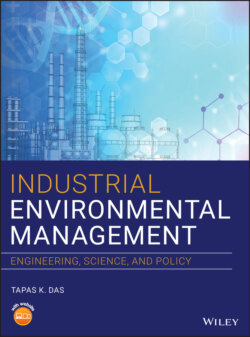Читать книгу Industrial Environmental Management - Tapas K. Das - Страница 123
2.13.2.2 Air
ОглавлениеAir (Prevention and Control of Pollution) Act, 1981To counter the problems associated with air pollution, ambient air quality standards were established under the 1981 Act. The Act provides means for the control and abatement of air pollution. The Act seeks to combat air pollution by prohibiting the use of polluting fuels and substances as well as by regulating appliances that give rise to air pollution. Under the Act, establishing or operating of any industrial plant in the pollution control area requires consent from state boards. The boards are also expected to test the air in air pollution control areas, inspect pollution control equipment, and manufacturing processes.
National Ambient Air Quality Standards (NAAQS) for major pollutants were notified by the CPCB in April 1994. These are deemed to be levels of air quality necessary with an adequate margin of safety, to protect public health, vegetation, and property (CPCB 1995 cited in Gupta 1999). The NAAQS prescribe specific standards for industrial, residential, rural, and other sensitive areas. Industry‐specific emission standards have also been developed for iron and steel plants, cement plants, fertilizer plants, oil refineries, and the aluminum industry. The ambient quality standards prescribed in India are similar to those prevailing in many developed and developing countries.
To empower the central and state pollution boards to meet grave emergencies, the Air (Prevention and Control of Pollution) Amendment Act, 1987, was enacted. The boards were authorized to take immediate measures to tackle such emergencies and recover the expenses incurred from the offenders. The power to cancel consent for nonfulfillment of the conditions prescribed has also been emphasized in the Air Act Amendment.
The Air (Prevention and Control of Pollution) Rules formulated in 1982 defined the procedures for conducting meetings of the boards, the powers of the presiding officers, decision making, the quorum, manner in which the records of the meeting were to be set, etc. They also prescribed the manner and the purpose of seeking assistance from specialists and the fee to be paid to them.
Complementing the above acts is the Atomic Energy Act of 1982, which was introduced to deal with radioactive waste. In 1988, the Motor Vehicles Act was enacted to regulate vehicular traffic, besides ensuring proper packaging, labeling, and transportation of the hazardous wastes. Various aspects of vehicular pollution have also been notified under the USEPA of 1986. Mass emission standards were notified in 1990, which were made more stringent in 1996. In 2000 these standards were revised yet again and for the first time separate obligations for vehicle owners, manufacturers, and enforcing agencies were stipulated. In addition, fairly stringent Euro I and II emission norms were notified by the Supreme Court on 29 April 1999 for the city of Delhi. The notification made it mandatory for car manufacturers to conform to the Euro I and Euro II norms by May 1999 and April 2000, respectively, for new noncommercial vehicle sold in Delhi.
